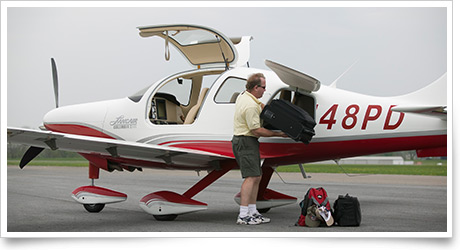| The following stories from the Aug. 10, 2012, edition of AOPA ePilot were provided to AOPA members who expressed an interest in the particular subject areas. Any AOPA member can receive information tailored to their areas of interest by updating their preferences online |
training tipsWeight: Worth the worry?
What to do now?
Whether it is the number of passengers, the quantity of baggage, or the amount of fuel that must be cut back to bring the flight within limits, don’t give in to any temptation to ignore the problem because of the inconvenience a change of plans would cause. That could be the beginning of trouble—for a long list of reasons.
Even if an overloaded aircraft gets airborne, its climb rate may be inadequate to clear surrounding terrain, especially when density-altitude conditions are eroding performance (see the July 27 “Training Tip: Hedging the heat”).
But that’s just one problem. You’ve heard it said that flying an improperly loaded aircraft makes you an unofficial test pilot. That’s because the aircraft is literally “off the charts” for calculating performance and stability (as determined by the center of gravity position). An aircraft loaded with a CG beyond the aft limits may become more unstable as fuel is consumed and the CG creeps rearward. That could prolong or even prevent a stall recovery.
Then there’s the landing. Aircraft tires, landing gear, and other structural components are made to take a lot of abuse, but there are limits to their ability to compensate for a pilot’s errors. Aircraft weight is often cited as a probable accident cause—even when an aircraft is merely heavy and not overloaded. That’s especially so if other performance-robbing factors were present when the decision was made to launch.
An overloaded aircraft “may exhibit unexpected and unusually poor flight characteristics,” cautions Chapter 9 of the Pilot’s Handbook of Aeronautical Knowledge.
Excess weight, the chapter says, reduces aircraft performance “in almost every aspect.”
As examples, the chapter offers this list: “Higher takeoff speed, longer takeoff run, reduced rate and angle of climb, lower maximum altitude, shorter range, reduced cruising speed, reduced maneuverability, higher stalling speed, higher approach and landing speed, longer landing roll, and excessive weight on the nose wheel or tail wheel.”
Is that the description of an aircraft that a safety-conscious pilot would fly? training productsQREF Flight Instructor Notebook (Instrument Pilot)Flight instructors who are training for the instrument instructor rating now have a resource. The QRef Flight Instructor Notebook (Instrument Pilot) includes a 42-lesson instrument rating syllabus, 125 instrument rating/proficiency check and study guide questions with detailed answers, 46 practical test standards topic lesson plans, and a checkride checklist, plus other resources. Order it online for $37.99 from PilotMall.com.
Note: Products listed have not been evaluated by ePilot editors unless otherwise noted. AOPA assumes no responsibility for products or services listed or for claims or actions by manufacturers or vendors. final examQuestion: On a recent flight I heard a pilot state “minimum fuel” in his initial call to the tower. What exactly did he mean and what kind of help was he hoping to get from ATC?
Answer: A pilot’s fuel planning will hopefully prevent this situation. However, if you do find yourself reaching your destination with your fuel so low that any undue delay would cause a critical situation, you should advise ATC of your minimum fuel status. On your initial contact with ATC state the words “minimum fuel” following your call sign. Keep in mind that this is not an emergency situation. You are merely advising ATC that your situation might turn into an emergency if there are any undue delays. If your fuel status is such that you need traffic priority, it would be wise to declare an emergency and deal with the consequences after you have safely landed. For more on minimum fuel requirements, read AOPA’s Legal Briefing, “Got enough fuel?”
Got a question for our technical services staff? Email [email protected] or call the Pilot Information Center, 800/872-2672. Don’t forget the online archive of “Final Exam” questions and answers, searchable by keyword or topic. |
 It’s not uncommon for a pilot to total up the weight to be carried on a planned trip and discover that it exceeds the
It’s not uncommon for a pilot to total up the weight to be carried on a planned trip and discover that it exceeds the 

